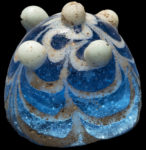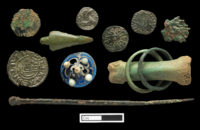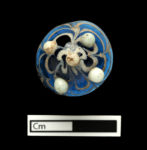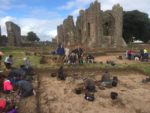 An extremely rare blue glass gaming piece from the Viking era has been discovered on Lindisfarne, the Northumbrian island where the first Viking raid struck Britain in 793 A.D. It is gumdrop shaped, made of translucent azure glass decorated around the outside with delicate rings of opaque white glass swirls and topped with five white glass globules that look like an abstract crown.
An extremely rare blue glass gaming piece from the Viking era has been discovered on Lindisfarne, the Northumbrian island where the first Viking raid struck Britain in 793 A.D. It is gumdrop shaped, made of translucent azure glass decorated around the outside with delicate rings of opaque white glass swirls and topped with five white glass globules that look like an abstract crown.
The piece was unearthed last September during a community excavation of the priory site. The stone priory was built in the 12th century hundreds of years after the original wooden monastery was in ruin. The exact location  of the monastery is unknown, but the excavation has unearthed a workshop building of the monastery and part of an associated cemetery dating to around 700-1000 A.D. Other artifacts discovered in the 2019 dig include two copper rings, a bronze buckle, a copper pin, several Anglo-Saxon coins and rare “namestones,” carved stones made to commemorate individuals who were buried on the Holy Isle.
of the monastery is unknown, but the excavation has unearthed a workshop building of the monastery and part of an associated cemetery dating to around 700-1000 A.D. Other artifacts discovered in the 2019 dig include two copper rings, a bronze buckle, a copper pin, several Anglo-Saxon coins and rare “namestones,” carved stones made to commemorate individuals who were buried on the Holy Isle.
The game piece’s finder was Heather Casswell, mother of the Head of Fieldwork who was chipping in on the dig to celebrate her birthday with her son. (Best. Present. Ever.) Archaeologists have identified it as a gaming piece, probably the King, used to play the Viking board game hnefatafl  (“king’s table”) which had numerous versions including ones local to Britain that are all believed to have descended from the Roman wargame Ludus Latrunculorum. The aim of the game was to protect the king, so even though nothing else from the game set was found, it looks like the goal was achieved for a thousand years or so. While tafl pieces made of wood and bone have been found before in wealthy Anglo-Saxon burials, only one other glass piece has been discovered in the British Isles: at the Pictish site of Dundurn in Scotland.
(“king’s table”) which had numerous versions including ones local to Britain that are all believed to have descended from the Roman wargame Ludus Latrunculorum. The aim of the game was to protect the king, so even though nothing else from the game set was found, it looks like the goal was achieved for a thousand years or so. While tafl pieces made of wood and bone have been found before in wealthy Anglo-Saxon burials, only one other glass piece has been discovered in the British Isles: at the Pictish site of Dundurn in Scotland.
“Many people will be familiar with Viking versions of the game, and I’m sure plenty of people will wonder whether this gaming piece was dropped by a Viking during the attack on Lindisfarne, but we believe it actually belonged to a version of the game that was played by the elites of Northern Britain before the Vikings ever set foot here,” said Lisa Westcott Wilkins, Managing Director of DigVentures.
“The Romans were very fond of giving gaming pieces as gifts to ‘barbarian’ princes, and as the game spread out of the Roman empire, different societies developed their own variations on the rules, including Northern Britain.
“In fact, we believe the piece had probably originally been buried with a member of the Northumbrian elite, whose grave was later disturbed.”
“It’s amazing to think that when the Vikings did land here they could, in theory, have sat down with the monks of Lindisfarne to play a game that would have been familiar to both cultures, although they would almost certainly have argued over whose rules to play by!” continued Westcott Wilkins.
The Lindisfarne excavation, which will return for its fifth season next September, is run by DigVentures, a company that crowdfunds archaeological digs that are open to public participation, in partnership  with Durham University. Contributors to the fundraising campaign garner awards ranging from access to a video stream of the dig to a DigCamp for kids, to a week of cleaning artifacts to a full two weeks of digging in the dirt. DigVentures train all the volunteers who work alongside professional archaeologists. Judging from the pictures full of happy people on their knees in the dirt with trowels in their hands grinning ear to ear, looks like they have no trouble getting contributions even at the highest support levels.
with Durham University. Contributors to the fundraising campaign garner awards ranging from access to a video stream of the dig to a DigCamp for kids, to a week of cleaning artifacts to a full two weeks of digging in the dirt. DigVentures train all the volunteers who work alongside professional archaeologists. Judging from the pictures full of happy people on their knees in the dirt with trowels in their hands grinning ear to ear, looks like they have no trouble getting contributions even at the highest support levels.